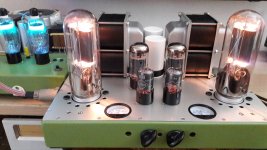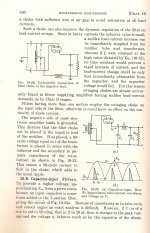I think the GM 70 would be better than 845 bought some, but have not had time to make an amp. so many SE 845 have very poor dynamics, a friend just paid $a 48000 fort two mono blocks.
Member
Joined 2009
Paid Member
that looks really nice!
my 845’s are destined for a single mono amp (Sakuma ?); I bought a pair last year, one for the final output and the other as a spare.
my 845’s are destined for a single mono amp (Sakuma ?); I bought a pair last year, one for the final output and the other as a spare.
Member
Joined 2009
Paid Member
Zekk, looks great, but.....that’s weird, I responded to your post with a compliment and now your post appears after mine. There has been a rip in the spacetime continuum.
My humble low watter 845 SET, operates at 530v and bias 55mA. Power supply is by a pair of mercury rectifiers DCG4/1000 together with a total 80uf capacitance using only oil caps throughout. Componants line-up are 6N7G>EL34>845>4K7 Double-C>Altec 604-E all for a soothing and delightful listening pleasure.
Regards from Singapore.
Zekk
Regards from Singapore.
Zekk
Attachments
I don't see a choke or other limiting device on those DCG4/1000 Hg rectifiers. Are they running straight into all those oil caps?😱
That is a great looking amplifier!
And I like the tube line up too, except for the mercury vapor rectifiers.
Please post a schematic.
I have always wanted an SE 845 amplifier, but only with relatively low B+ voltage.
If you are using the EL34 in pentode mode, consider using an OD3 for color, and for powering the screen.
But of course the amp is working well, so do not change a thing.
Enjoy listening.
And I like the tube line up too, except for the mercury vapor rectifiers.
Please post a schematic.
I have always wanted an SE 845 amplifier, but only with relatively low B+ voltage.
If you are using the EL34 in pentode mode, consider using an OD3 for color, and for powering the screen.
But of course the amp is working well, so do not change a thing.
Enjoy listening.
Last edited:
The fat-boy EL34, is triode wire, separately fix bias at 18mA. 6N7G is replaced with 6J5G or L63. Directly plug-in without re-wiring,and bias with 3x LED.
I don't see a choke or other limiting device on those DCG4/1000 Hg rectifiers. Are they running straight into all those oil caps?😱
Do you think I'm really that dumb!?
I drew inspiration from PHILIPS's EL6400 Series of high power amplifiers.
Choke is wired on the negative rail, center tap>choke>grnd.
Last edited:
I believe the amplifier is working, and has been working for a long time.
Right?
Never argue with success.
Right?
Never argue with success.
Zekk,
6J5G and EL34 triode wired seems like a good way to go.
I recently built a push pull amp with KT77 outputs in Ultra Linear.
The Beam Power KT77 is the direct Cousin of the EL34 Pentode.
The EL34 has the Suppressor on Pin1.
The KT77 Beam Formers are internally connected to the Cathode, and Pin 1 is not connected to the tube base.
You already have the Pin 1 to Pin 8 connection on your EL34 socket, so tube rolling is easy from EL34 to KT77. Plug and Play.
The specifications are so similar, I would not expect much change in the performance or in the sound.
6J5G and EL34 triode wired seems like a good way to go.
I recently built a push pull amp with KT77 outputs in Ultra Linear.
The Beam Power KT77 is the direct Cousin of the EL34 Pentode.
The EL34 has the Suppressor on Pin1.
The KT77 Beam Formers are internally connected to the Cathode, and Pin 1 is not connected to the tube base.
You already have the Pin 1 to Pin 8 connection on your EL34 socket, so tube rolling is easy from EL34 to KT77. Plug and Play.
The specifications are so similar, I would not expect much change in the performance or in the sound.
Choke in PS Negative Lead
JD Ryder knew his stuff when he wrote this text book on Electrical Engineering in 1957. The information is offered on a 'might as well know' basis. Others may be interested as well.
There are many problems on the way to success, this is simply one of them. Might get in the way, might not.😀
JD Ryder knew his stuff when he wrote this text book on Electrical Engineering in 1957. The information is offered on a 'might as well know' basis. Others may be interested as well.
There are many problems on the way to success, this is simply one of them. Might get in the way, might not.😀
Correction to Mr. JD Ryder's text book:
He says that "the choke has 60 cycle current through it".
No, Wrong, but it does have 120 Unidirectional alternations per second through it.
And, the 845 amplifier that is being discussed is Single Ended, Class A, with capacitors after the choke.
It is not a class B push pull amplifier (such class B amplifiers do have large differences in B+ current of the quiescent state versus maximum output power).
Now we know better where to watch out for the potential problem.
Not in class A single ended or class A push pull (I did not say push pull class AB).
He says that "the choke has 60 cycle current through it".
No, Wrong, but it does have 120 Unidirectional alternations per second through it.
And, the 845 amplifier that is being discussed is Single Ended, Class A, with capacitors after the choke.
It is not a class B push pull amplifier (such class B amplifiers do have large differences in B+ current of the quiescent state versus maximum output power).
Now we know better where to watch out for the potential problem.
Not in class A single ended or class A push pull (I did not say push pull class AB).
Last edited:
I don't get it, what's the big fuss over a choke wired on the negative rail? It's operating perfectly stable and idly silent. But on the other hand, nothing is perfect in this world.
I copy from Philips Holland's design for their EL6400 Series of high power amplifier. I do not follow blindly what those guy's judgement based on man-made equipment, calibrated to suit one's hearing. I trust nature's creation of my ears, giving me the power of listening.
I copy from Philips Holland's design for their EL6400 Series of high power amplifier. I do not follow blindly what those guy's judgement based on man-made equipment, calibrated to suit one's hearing. I trust nature's creation of my ears, giving me the power of listening.
Better read this, you may still have created a problem in your amplifier system.🙂
What's there to read? If the prevailing situation have no problem, don't look for problem.
Zekk,
Keep listening. Your amplifier works.
My post was rather wordy, but it defended your amplifier design.
Mr. JD Ryders article did not apply to your amplifier.
And, it also had a technical error.
Even the best of writers make a mistake once in a while.
He missed on a technicality, but the book was a technical book.
Keep listening. Your amplifier works.
My post was rather wordy, but it defended your amplifier design.
Mr. JD Ryders article did not apply to your amplifier.
And, it also had a technical error.
Even the best of writers make a mistake once in a while.
He missed on a technicality, but the book was a technical book.
Last edited:
You're absolutely right, 6AsUMMER!
My contribution here is partly to share and rejoice that this cheapie Shuguang 845 costing merely $130 a pair can be that good. Previously, I was scare-off by that 1kv B+, until I read about low power 845 SET in MJ Magazine. My Tele EL156 costing $450 a pair cannot even comes close. It's all about what separates the boys from the men.
My contribution here is partly to share and rejoice that this cheapie Shuguang 845 costing merely $130 a pair can be that good. Previously, I was scare-off by that 1kv B+, until I read about low power 845 SET in MJ Magazine. My Tele EL156 costing $450 a pair cannot even comes close. It's all about what separates the boys from the men.
Last edited:
Member
Joined 2009
Paid Member
Power Frequency Ripple Reduction in Power Supplies
Amazing how amateurs can trash the work of a professional without offering any kind of proof. Here is another potential problem described with proof & a simple fix.🙂Again, in the category of 'may as well know'.
Not required reading, there is no test!😱
Amazing how amateurs can trash the work of a professional without offering any kind of proof. Here is another potential problem described with proof & a simple fix.🙂Again, in the category of 'may as well know'.
Not required reading, there is no test!😱
Attachments
Member
Joined 2009
Paid Member
I too believe JD Ryder is correct. But this is a parasitic effect, based on the interwinding capacitance that may produce an insignificant contribution to audible noise. The real life test was to build the amp and it works just fine.
- Home
- Amplifiers
- Tubes / Valves
- 845 Low voltage SE AMP

